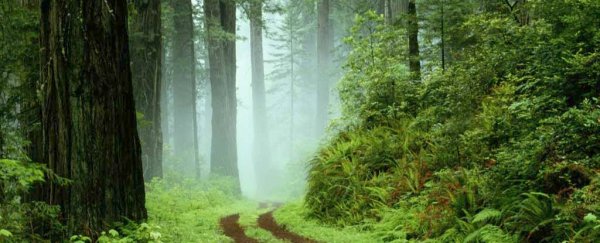Migration is tough for all living things. After all, it's usually triggered because a certain habitat has become inhospitable for one reason or another. Even creatures like us who can pack up and leave in a moment's notice struggle to find new homes. So can you imagine how much it sucks for forests?
We generally think of forests as stationary ecosystems - they're something that other plants and animals live in. You'd never, say, walk to a local park to find that it's moved to a new location in a better neighbourhood overnight.
But, while it seems like that's the case, forests can actually migrate if needed, they just do it differently, relying mostly on luck to get where they need to go.
Of course, we're not talking about plants physically walking like the Ents from Lord of the Rings or Ecuador's 'walking palm trees' - which, by the way, don't actually walk anywhere. Banana plants that do actually physically move, but that's just the result of the way they're cultivated.
As Juliet Lamb explains for JSTOR Daily, most forests and plants migrate by using nature as a whole, employing multiple tactics to ensure that future generations live better lives.
Mostly, these tactics come down to one thing: seed dispersal. In order to move, a plant needs to first produce seeds - hopefully, hardy ones in large quantities. Then, they must get those seeds somewhere more sustainable.
This is where some major trickery comes in.
Have you ever wondered why so many fruits taste so good right off a tree? It's not because we've grown to like them over the years, it's because fruit trees have evolved to produce fruits that animals like to eat, so they can have us and other creatures consume - and then poop out - their seeds far away from the original source.
Other methods include dropping seeds into rivers to have them float away, or dropping them into the breeze to be carried by an animal on its fur - or clothing.
All of these tactics help spread seeds to different locations with the hope that some of them will land and sprout in a region that's ideal for a new home.
In fact, according to a 1939 paper written by naturalists John Potzger and Ray Friesner, following vegetation can tell us a lot about climate shifts:
"Vegetation is always an expression of the climate, and as climate changed, great masses of vegetation developed, advanced, retreated, or in many instances, perished, leaving only the carbonised remains deep in the strata in parts of the globe where today cheerless winds blow monotonously over bleak ice and snowfields thousands of feet in depth."
As you can imagine, this type of migration is a long, long process that takes many years to complete. Throughout most of history, it has unfolded over millennia, but nowadays, forests aren't given that long to move, because temperatures are rising faster than ever before.
But the good news is scientists have devised a pretty intense way of pushing them to migrate faster: flamethrowers.
Yup, flamethrowers are actually helping conservationists give forests the nudge they need to move a bit quicker - lighting a fire under them in a literal sense.
Researchers call this process 'assisted migration', and it's implemented in pine forests where fire is actually an important part of the trees' lifecycle, reports Elizabeth Harball at ClimateWire.
A notable example of this occurred back in 2014, when the Washington DC wing of the Nature Conservancy burned down a 20-acre patch of forest in Maryland after planting new saplings in an area just out of their natural climate.
Basically, these longleaf pines struggle to grow around other plants. So, forest fires - normally a naturally occurring event spurred on by lightning - help level the playing field for new ones to take root.
So assisted migration helps move trees to areas just out of their comfort level, which scientists think will be the perfect climate for them in the future, based on computer models and ecological studies.
Even though humans play a role for this type of migration, it's essentially the same thing as seed dispersal, but with the added advantage of reduced competition for resources.
Forests are migrating right now as you read this. They're just doing it in such a way that you probably would never notice.
